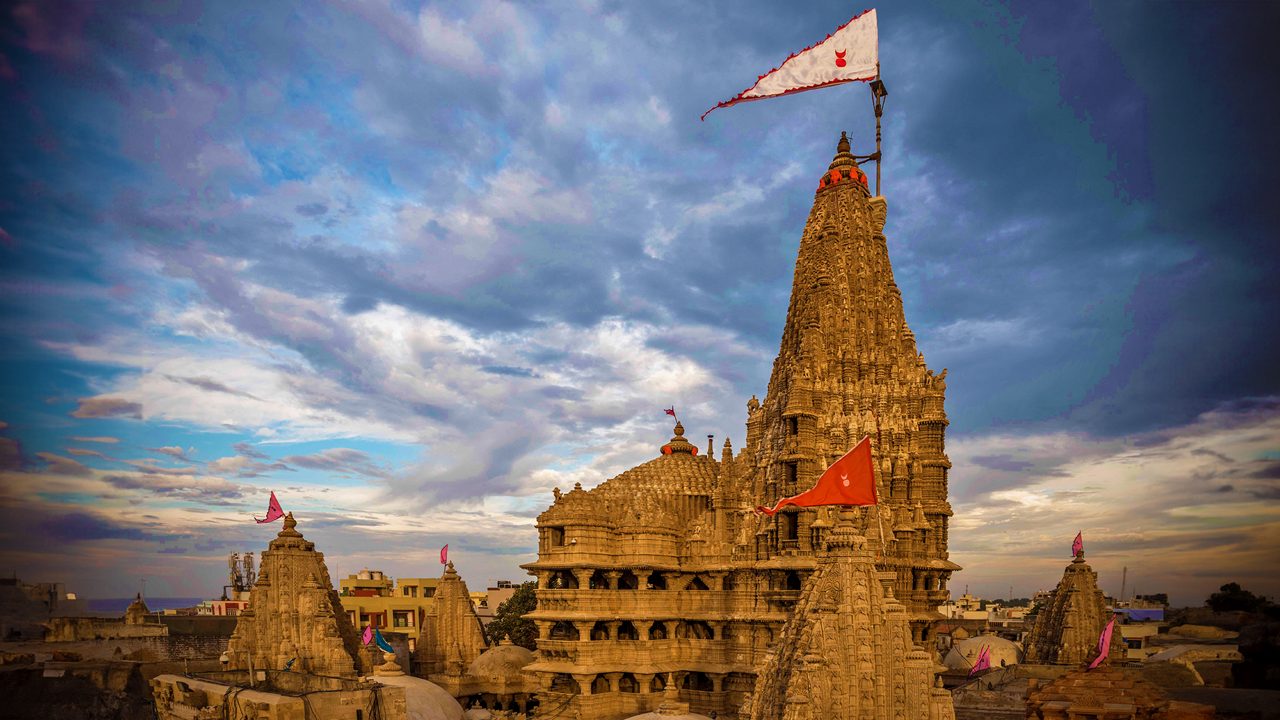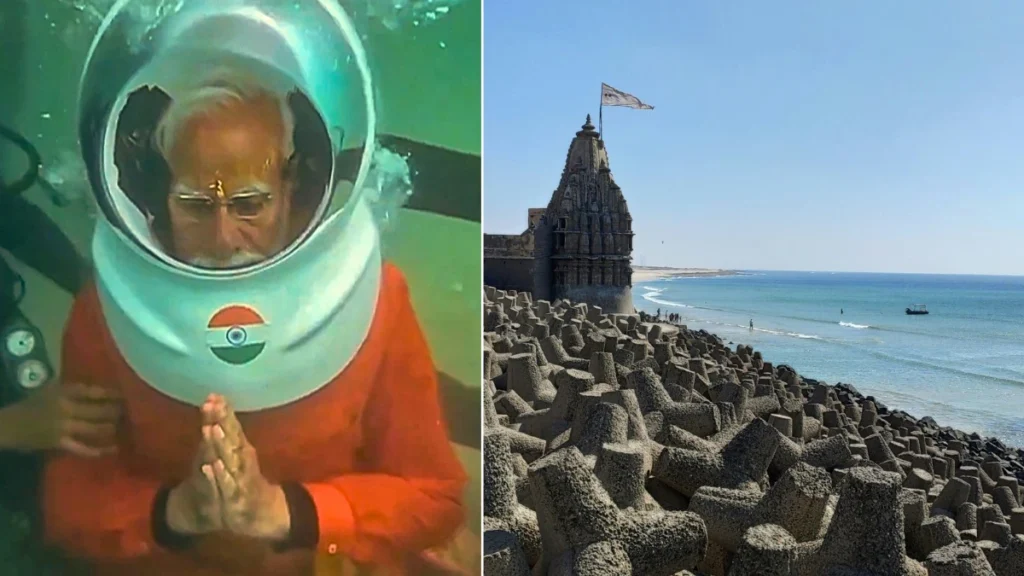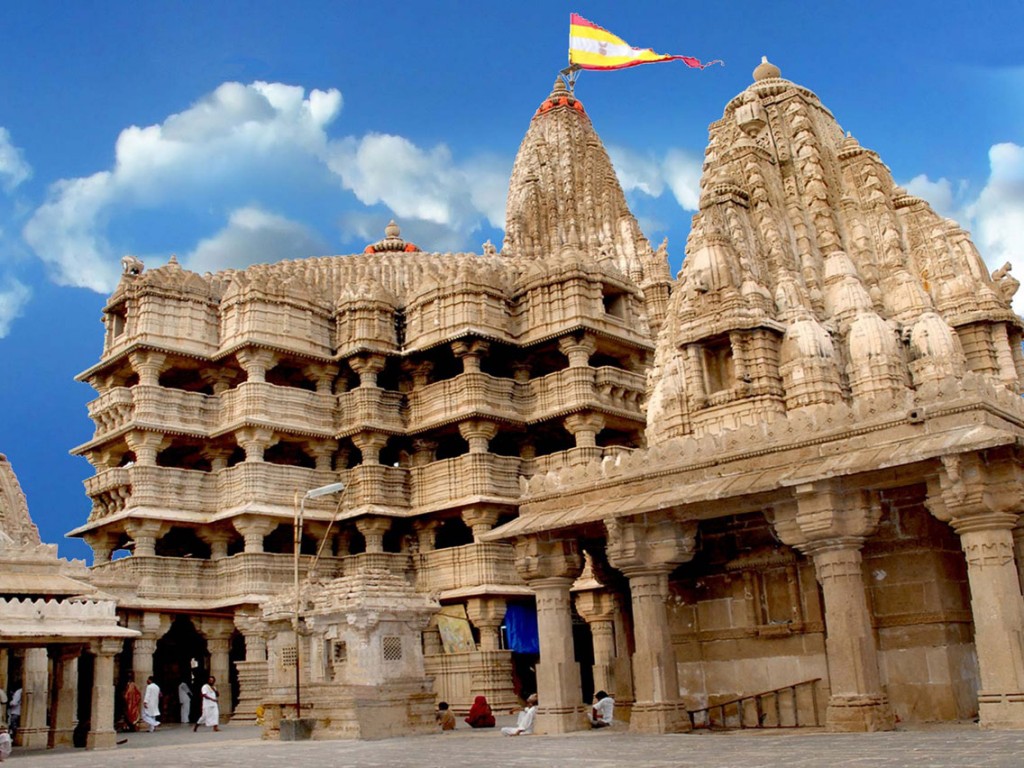
Dwarka
Table of Contents
The Dwarkadheesh Temple, also known as the Jagat Mandir, stands as a beacon of spirituality, history, and architectural brilliance in the holy city of Dwarka, Gujarat. Dedicated to Lord Krishna, this temple is one of the four cardinal pilgrimage sites, or “Char Dham,” and holds a special place in the hearts of millions of devotees.
Nestled on the western tip of the Saurashtra peninsula, the Dwarkadheesh Temple is not only a spiritual destination but also a cultural treasure that narrates the tales of devotion, mythology, and ancient Indian architecture. Let’s embark on a journey to explore the grandeur and spiritual significance of this sacred site.
Historical Significance
The Dwarkadheesh Temple is believed to have been built over 2,500 years ago by Vajranabh, the great-grandson of Lord Krishna. According to Hindu mythology, Dwarka was the capital of Lord Krishna’s kingdom, a golden city submerged by the sea after his departure from the mortal world. Archaeological excavations have revealed submerged structures near Dwarka, lending credence to these ancient tales.
Over the centuries, the temple has undergone several renovations, with the current structure dating back to the 15th-16th century. Its rich history is a testimony to the devotion of various dynasties and rulers who contributed to its preservation and enhancement.
Architectural Marvel
The Dwarkadheesh Temple is a quintessential example of ancient Hindu temple architecture. Built in the Chalukya style, the temple stands tall at approximately 51.8 meters (170 feet). Its five-story structure is supported by 72 intricately carved pillars, showcasing the artistry and craftsmanship of the bygone era.
Key Architectural Features:
- Shikhar (Spire): The temple’s towering shikhar, adorned with intricate carvings, is visible from a distance and serves as a beacon for devotees.
- Flag (Dhwaja): A 52-yard-long flag with symbols of the sun and moon is hoisted atop the temple daily, signifying Lord Krishna’s eternal presence.
- Garbha Griha (Sanctum Sanctorum): The sanctum houses the black marble idol of Lord Krishna, revered as Dwarkadheesh or “King of Dwarka.”
- Mandapas: The temple’s spacious halls are adorned with sculptures depicting various deities, mythological scenes, and intricate floral patterns.
The temple’s location, overlooking the Arabian Sea, adds to its spiritual ambiance, making it a perfect blend of divinity and natural beauty.
Spiritual Significance
The Dwarkadheesh Temple holds immense significance in Hinduism, especially for devotees of Lord Krishna. It is believed that visiting this temple fulfills one’s spiritual aspirations and leads to salvation. As part of the Char Dham Yatra, it is considered a mandatory pilgrimage for devout Hindus.
Legends Associated with the Temple:
- Dwarka – The Golden City: According to the Mahabharata and Puranas, Lord Krishna established Dwarka after leaving Mathura to provide a safe haven for his people.
- Submersion of Dwarka: The city’s submergence is seen as a divine act, symbolizing the impermanence of material wealth and the eternal nature of spirituality.
- Rukmini Temple: Nearby, the Rukmini Devi Temple, dedicated to Lord Krishna’s consort, adds another layer of devotion and mythology to the region.
Rituals and Festivals
The temple’s daily rituals and annual festivals are a testament to its vibrant spiritual life. From the early morning Mangla Aarti to the Shayan Aarti at night, each ritual is performed with utmost devotion.
Daily Rituals:
- Mangla Aarti: Early morning prayers to awaken the deity.
- Shringar Aarti: Decorating the idol with flowers, jewelry, and garments.
- Rajbhog Aarti: Offering a grand meal to the deity.
- Sandhya Aarti: Evening prayers with lamps and chants.
- Shayan Aarti: Night prayers to put the deity to rest.
Major Festivals:
- Janmashtami: Celebrating the birth of Lord Krishna with great fervor. The temple is adorned with lights, flowers, and devotees throng the premises to witness the midnight aarti.
- Holi: Marked by vibrant colors and joyous celebrations, reflecting Krishna’s playful nature.
- Diwali: The temple is illuminated, symbolizing the victory of light over darkness.
- Anniversary of the Flag: A special ceremony is held annually to commemorate the temple’s iconic flag.
The Pilgrimage Experience
A visit to the Dwarkadheesh Temple is a spiritually enriching experience. Devotees are welcomed with the sound of temple bells, the aroma of incense, and the rhythmic chants of “Jai Shri Krishna.”
Key Attractions for Pilgrims:
- Sudama Setu: A pedestrian bridge named after Sudama, Krishna’s childhood friend, offering a scenic view of the Gomti River.
- Gomti Ghat: A sacred spot for rituals and bathing, believed to cleanse one’s sins.
- Dwarka Lighthouse: A short distance from the temple, providing panoramic views of the Arabian Sea.
- Bhadkeshwar Mahadev Temple: A Shiva temple submerged during high tide, reflecting the unity of Shaivism and Vaishnavism.
Accessibility and Accommodation
Getting There:
- By Air: The nearest airport is Jamnagar, approximately 137 km from Dwarka.
- By Train: Dwarka is well-connected by rail to major cities like Ahmedabad and Mumbai.
- By Road: Regular buses and taxis are available from nearby towns and cities.
Accommodation: Dwarka offers a range of accommodations, from budget lodges to luxury hotels. The temple trust also provides guesthouses for pilgrims.
Preservation and Modern Initiatives
The Dwarkadheesh Temple is a protected monument under the Archaeological Survey of India (ASI). Efforts are being made to preserve its heritage while enhancing facilities for pilgrims. Initiatives like clean energy, waste management, and digital darshan options are being implemented to make the pilgrimage more sustainable.
Conclusion
The Dwarkadheesh Temple is not just a place of worship but a timeless symbol of faith, devotion, and Indian heritage. Its spiritual aura, coupled with its historical and architectural grandeur, makes it a must-visit destination for devotees and tourists alike.
A journey to this sacred abode is more than a pilgrimage; it’s a voyage into the heart of India’s rich cultural and spiritual tapestry. As you stand before the magnificent idol of Lord Krishna, amidst the chants and the sea breeze, you feel an indescribable connection to the divine, a moment of true bliss.
So, plan your visit to the Dwarkadheesh Temple and immerse yourself in the spiritual legacy of Lord Krishna. As the scriptures say, “Where Krishna resides, there lies heaven itself.”


